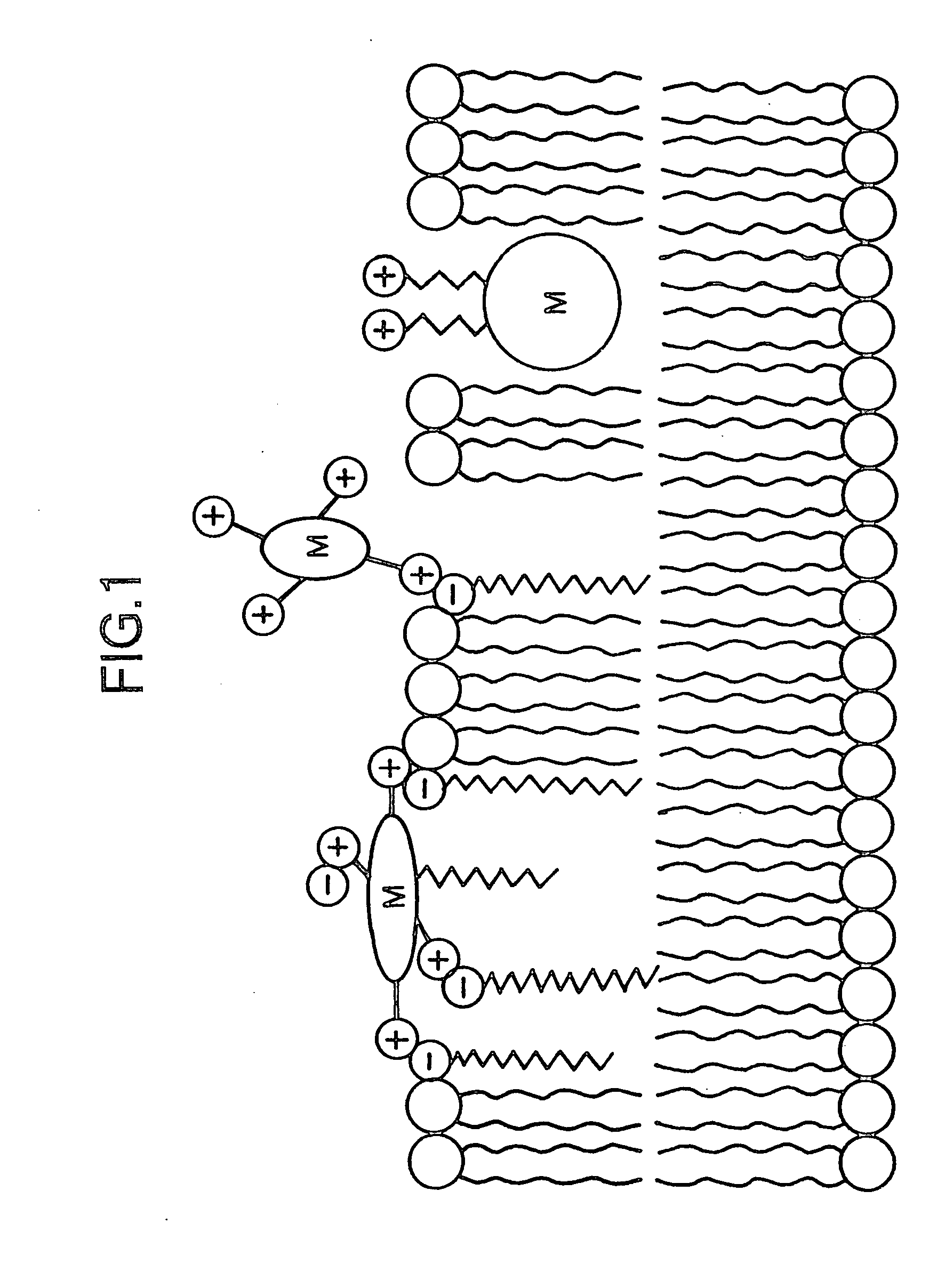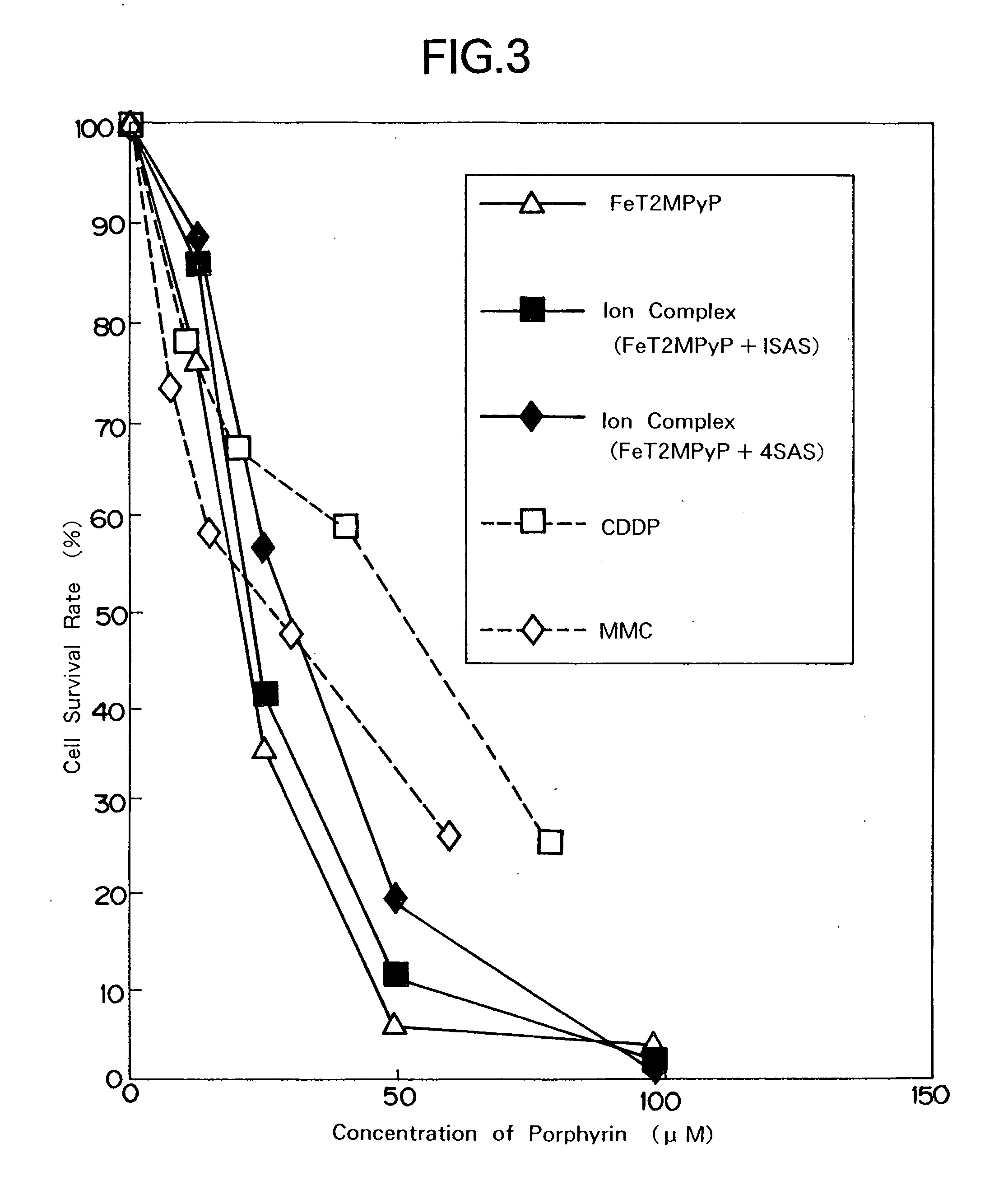Metal-porphyrin-complex-embedded liposomes, production process thereof, and medicines making use of the same
a metal-porphyrin complex and liposome technology, applied in the field of metal-porphyrincomplexembedded liposomes, can solve problems such as potential problems in the administration of a metalloporphyrin complex by itself into the body, and achieve the effects of lowering concentration, safe administration of metalloporphyrin complex, and excellent sod activity
- Summary
- Abstract
- Description
- Claims
- Application Information
AI Technical Summary
Benefits of technology
Problems solved by technology
Method used
Image
Examples
example 1
Synthesis of iron[5,10,15,20-tetrakis(2-methylpyridyl)porphyrin](FeT2 MPyP)
(1) After heating propionic acid (500 mL) to 100° C. under stirring, 2-pyridylcarboxyaldehyde (15 mL, 0.158 mol) was added. Subsequently, pyrrole (12 mL, 0.173 mol) was added little by little dropwise by a syringe, and refluxing was conducted at 100° C. for 1 hour to effect cyclizing condensation. Subsequent to the reaction, the reaction mixture was allowed to cool down to room temperature, and the solvent was distilled off. Neutralization, washing and column chromatography (alumina basic type I, chloroform) were performed to afford 5,10,15,20-tetrakis(2-pyridyl)porphyrin as the target product [yield: 1.1 g, (4.4%)].
1H-NMR δH (CDCl3, ppm): −2.82(2H, H in pyrrole NH), 7.72-9.14(16H, H in pyridine), 8.87(8H, H in pyrrole).
UV-vis λmax (chloroform, m): 418, 513, 544, 586, 645.
FAB-Mass (m / z): 619, 620.
(2) Under an argon (Ar) atmosphere, 5,10,15,20-tetrakis(2-pyridyl)porphyrin (0.2 g, 3.2×10−4 mol) obta...
example 2
Synthesis of iron[[1,3,5,8-tetramethyl-2,4-divinyl-6,7-di(4-methylpyridylamidoethyl)]porphyrin](FePPIX-DMPyAm)
A solution of iron[[1,3,5,8-tetramethyl-2,4-divinyl-6,7-di(carboxyethyl)]porphyrin] (500 mg, 8.1×10−4 mol) in a 10:1 mixed solvent of tetrahydrofuran and triethylamine (110 mL) was chilled, to which ethyl chloroformate (0.33 mL, 2.0×10−3 mol) was added, followed by a reaction for 90 minutes. 4-Aminopyridine (0.20 g, 2.0×10−3 mol) was then added, followed by a further reaction for 1 hour. Subsequently, the reaction mixture was allowed to stand overnight at room temperature.
After the solvent was distilled off, purification was conducted by column chromatography [silica gel, methanol / water (9 / 1)] and recrystallization to afford iron[[1,3,5,8-tetramethyl-2,4-divinyl-6,7-di(4-pyridylamidoethyl)]porphyrin] as a precursor (yield: 30 mg).
UV-vis λmax (methanol, m): 398, 485, 596, 643.
FAB-Mass (m / z): 767.
(2) The above-described precursor (30 mg, 3.9×10−5 mol) and methyl p...
example 3
Synthesis of manganese[5,10,15,20-tetrakis(4-methylpyridyl)porphyrin](MnT4 MPyP)
(1) 4-Pyridylcarboxyaldehyde (15 mL) was added to propionic acid (500 mL), followed by heating. After the mixture had been heated to 100° C., pyrrole (12 mL) was added, and the thus-obtained mixture was refluxed for 1 hour. After the reaction, cooling, evaporation, neutralization and washing were conducted. Purification was then conducted by column chromatography (basic alumina, chloroform) to afford 5,10,15,20-tetrakis(4-pyridyl)porphyrin as purple crystals [yield: 1.68 g (7.08%)].
H-NMR δH (CDCl3, ppm): −2.9(2H, H in pyrrole NH), 8.2-9.1(16H, H in pyridine), 8.9(8H, H in pyrrole).
UV-vis λmax (chloroform, m): 417, 513, 546, 589, 641.
FAB-Mass (m / z): 619, 620.
(2) After a solution of 5,10,15,20-tetrakis(4-pyridyl)porphyrin (100 mg) obtained above in the procedure (1) in dimethylformamide (100 mL) was next purged with argon (Ar), manganese acetate tetrahydrate (370 mg) was added, followed by refl...
PUM
| Property | Measurement | Unit |
|---|---|---|
| Size | aaaaa | aaaaa |
| Concentration | aaaaa | aaaaa |
| Therapeutic | aaaaa | aaaaa |
Abstract
Description
Claims
Application Information
 Login to View More
Login to View More - R&D
- Intellectual Property
- Life Sciences
- Materials
- Tech Scout
- Unparalleled Data Quality
- Higher Quality Content
- 60% Fewer Hallucinations
Browse by: Latest US Patents, China's latest patents, Technical Efficacy Thesaurus, Application Domain, Technology Topic, Popular Technical Reports.
© 2025 PatSnap. All rights reserved.Legal|Privacy policy|Modern Slavery Act Transparency Statement|Sitemap|About US| Contact US: help@patsnap.com



